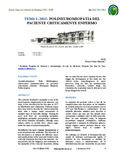Mostrar el registro sencillo del ítem
POLINEUROMIOPATIA DEL PACIENTE CRITICAMENTE ENFERMO
POLINEUROMIOPATIA DEL PACIENTE CRITICAMENTE ENFERMO
| dc.creator | Vindas Miranda, Tatiana | |
| dc.date.accessioned | 2015-06-22T17:34:51Z | |
| dc.date.available | 2015-06-22T17:34:51Z | |
| dc.date.issued | 2011-01-01 00:00:00 | |
| dc.identifier.citation | http://revistas.ucr.ac.cr/index.php/clinica/article/view/6983 | |
| dc.identifier.issn | ||
| dc.identifier.uri | https://hdl.handle.net/10669/14677 | |
| dc.description.abstract | The critically ill patient’s myopathy is one of the most frequent complications in the intensive care units, it was described for the first time in 1977 by MacFarlane and collaborator. Different names have been used to describe the clinical status that more than a unique entity corresponds to multiple types of muscular damage. Among the most used there are: necrotizing myopathy,quadriplejic myopathy, post-paralysis syndrome and heavy filaments myopathy, although some authors prefer to include these clinical signs under the name of polyneuromyopathy. Nevertheless the most common denomination is acute neuromuscular syndrome. The objective of this document is to analyze the different causes and manifestations of the muscular weakness that critically ill patients develop in the intensive care unit period, and the diagnosis and evaluation of the myopathy of the critically ill patients, taking into account that the most common factors that trigger the development of this entity are: the clinical status, etiopathogenesis in sepsis processes, drug use like the neuromuscular blockaders, corticoids, sedative drugs, the relaxation, the respiratory muscle deficiency and the prolonged stay in bed. | |
| dc.description.abstract | La miopatía del paciente crítico es una de las complicaciones más frecuentes en las unidades de cuidado intensivo, descrita por primera vez en 1977 por MacFarlane y colaboradores. Se han utilizado diferentes nombres para describir el cuadro clínico que más que una entidad única corresponde a múltiples tipos de daño muscular. Entre los más utilizados están, la miopatía necrotizante, miopatía cuadripléjica, síndrome post-parálisis y miopatía de filamentos gruesos; aunque algunos autores prefieren abarcar estos signos clínicos bajo el nombre de polineuromiopatia. Sin embargo, no obstante la denominación más común de síndrome neuromuscular agudo, el objetivo de este documento es analizar las diferentes causas y manifestaciones de la debilidad muscular que desarrollan los pacientes críticamente enfermos, durante su estancia en unidad de cuidado intensivo, igual que el diagnóstico y evaluación, considerando que, la clínica, etiopatogenia en procesos de sepsis, utilización de fármacos como los bloqueantes neuromusculares, corticoides, sedación, relajación, alteración de músculos respiratorios y estancia prolongada en cama, son los factores más comunes que desencadenan el desarrollo de dicha entidad. | |
| dc.format.extent | - | |
| dc.relation.ispartof | Revista Clínica Escuela de Medicina UCR-HSJD Vol. 1 Núm. 1 2011 | |
| dc.subject | creatinfosfoquinasa | |
| dc.subject | falla multiorgánica | |
| dc.subject | alteraciones neuromusculares en pacientes críticamente enfermos | |
| dc.subject | neuropatía | |
| dc.subject | miopatía | |
| dc.subject | polineuropatía | |
| dc.title | POLINEUROMIOPATIA DEL PACIENTE CRITICAMENTE ENFERMO | |
| dc.title | POLINEUROMIOPATIA DEL PACIENTE CRITICAMENTE ENFERMO | |
| dc.type | artículo original | |
| dc.date.updated | 2015-06-22T17:34:51Z | |
| dc.language.rfc3066 | es | |
| dc.identifier.doi | 10.15517/rc_ucr-hsjd.v1i1.6983 |


